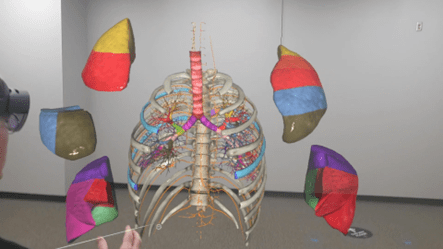Thank you for your interest in the Enhanced View Of Human Anatomy Using Augmented Reality crowdfunding project. This campaign has ended, but you can still support the Augmented Reality Anatomy Lab Fund by making a gift here, today!
Enhanced View of Human Anatomy Using Augmented Reality
The study of Human Anatomy, particularly cadaveric dissection, remains a foundational part of medical education. Mastering the subject requires spending a significant number of hours both preparing for a dissection as well as in the dissection lab. New technologies have and are being developed to make understanding, versus memorizing, anatomical structures more intuitive, including online computer simulations and programs. While helpful, these programs do not provide a 3D approach to studying the human body. Most recently, a new technology, Augmented Reality (AR), has been developed that allows groups of users to interact and “dissect” a 3D human hologram. This technology utilizes Microsoft HoloLens2 headsets and anatomy specific software (AnatomyX by Medivis) to create virtual “rooms” where small groups of students can both dissect the hologram and interact with an instructor or other students in real time.

As part of the Human Anatomy course for Physician Assistant students at Emory, the faculty conducted a small pilot study comparing exam performance of students who participated in AR sessions versus those who did not to evaluate the efficacy of supplementing cadaveric dissection by incorporating AR technology into the course. Results, both objective and subjective, indicated several benefits to using this technology including:
- Significantly improved test results, particularly on the lab exams.
- Significantly less time required for dissections and exam prep. For each hour of AR learning, students saved 3 – 4 hours, on average.
- Favorable feedback from students. 87.5% of participants had a favorable view of the AR technology while 83.9% felt the AR help them prepare for the exam and 83.9% felt the technology helped them learn the anatomy they did NOT dissect.
- Although a valuable supplement, AR technology does not replace cadaveric dissection.
The Impact of Your Gift
Based on these results, the PA program now seeks to expand use of AR technology to include all first-year students for all anatomy dissections. Additionally, this technology will be used to create a virtual neuroanatomy lab as part of the Neurology module for second-year students. While Emory funds have already covered more than $40,000-worth of headsets and the required software, this expansion will require the purchase of additional HoloLens2 headsets and associated software subscription costs. To cover these costs, the PA program has embarked on a fund-raising campaign and has already secured a commitment from one donor to match all funds raised.


